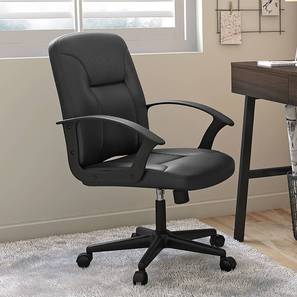The simple study chair has transformed from a piece of furniture to an essential tool for productivity, wellbeing, and sustained focus in an increasingly demanding academic and professional environment. If not supported appropriately, spending endless hours bent over textbooks, laptops, or drawing boards can have a serious negative impact on our health. An ergonomic study chair can significantly improve learning, reduce physical strain, and even improve cognitive function. Let’s examine the essential features that make a good chair great.
Ergonomic features
A study chair’s complete ergonomic adjustability is its defining feature. Since no two bodies are alike, a chair that works well must be able to accommodate a variety of heights and tastes so that each user can maintain ideal posture for extended periods. The most basic change is this one. Your feet will be able to rest flat on the floor thanks to the seat height’s precise adjustment. Maintaining appropriate spinal posture, lowering pressure on the lower back, and encouraging healthy circulation all depend on this alignment. For easy and accurate adjustments all day long, a smooth and dependable pneumatic lift mechanism is necessary.
Backrest recline and Lumbar support
In order to avoid stiffness during extended study sessions, the perfect backrest should provide a comfortable range of recline that permits dynamic posture changes. Most importantly, it needs to have a strong tilt lock mechanism. This allows you to lock the backrest at different angles, giving you constant lumbar support whether you’re sitting up straight to read, leaning forward to write, or reclining a little for quick breaks. Certain high-tech chairs have synchronized tilt, in which the backrest and seat move in unison to maintain the ergonomic angle. Preventing lower back pain, which is a common complaint among professionals and students, is crucial. The best chairs have lumbar support that is extremely adjustable, enabling depth and height adjustments. This allows you to accurately target the natural inward curve of your spine.
Adjustabilities
Adjustable armrests are essential for wrist, neck, and shoulder comfort, but they are frequently disregarded. They should enable you to write or type with your forearms supported at a height that maintains the comfort of your elbows and shoulders. They can be positioned to support a variety of tasks, from promoting good typing posture to stepping aside when you need to get closer to your desk, thanks to their depth and swivel capabilities. This flexibility greatly lessens the strain on the wrist and trapezius muscles. You can slide the seat pan forward or backward thanks to this essential feature. This guarantees that your back is properly supported by the backrest, promoting proper hip and spinal alignment, and avoiding uncomfortable pressure on the backs of your thighs, which can impede circulation.
Superior materials and built quality
The materials and construction of the perfect study chair should reflect its ability to endure daily, demanding use while retaining comfort and aesthetic appeal because it is an investment that will last for many years. High-density, molded foam that holds its shape and offers steady support over time should be used to make the seat cushion. High-quality foam evenly distributes pressure and offers the required cushioning without compromising support. Breathability is a must for prolonged study sessions in order to avoid discomfort and heat accumulation. Mesh backrests are a great way to encourage airflow, dissipate heat, and stop perspiration. Choose long-lasting, high-performing materials for fabric upholstery, such as natural fibers, commercial-grade polyester, or specialty breathable fabrics. The frame and base of the chair should be made of incredibly durable materials like steel, aluminum, or premium reinforced nylon. Long-term stability, longevity, and a high weight capacity are guaranteed by this sturdy construction. Comfort and safety can be compromised by flimsy construction, which can cause wobbling, creaking, and a noticeably shorter lifespan.
Design and Aesthetics
A study chair’s overall style and aesthetic appeal are also important, particularly since it becomes the focal point of a private study area. The design of the perfect chair should be both aesthetically pleasing and ergonomic. Its modern silhouette, clean lines, and well-considered proportions guarantee that it blends in with your study space without being unduly large or obtrusive. A well-made chair can encourage concentration and enhance the atmosphere of your workstation. Select the best study chair that complements your current decor, thanks to the variety of color and finish options available. This customization can improve the study space’s coherence, motivation, and enjoyment while also making it feel cozier. A study chair’s overall style and aesthetic appeal are also important, particularly since it becomes the focal point of a private study area.
Conclusion
More than just a place to sit, the perfect study chair is an essential part of a supportive, healthy, and effective learning environment. Choose a chair that not only supports your body but also actively improves your ability to focus, learn, and perform well by giving top priority to comprehensive ergonomic adjustability, excellent material and construction quality, careful design, unwavering stability, and practical user considerations.
For more articles, visit:
https://propernewstime.com/



